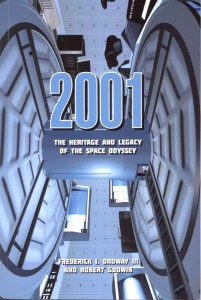To say that “2001: A Space Odyssey” is a seminal science fiction movie is a bit like suggesting that the early astronauts were brave men. So many people have written about the effect the film had on them as youngsters, how it turned their thoughts towards a career in space technology and how it will remain a classic for the foreseeable future that it seems as if nothing can be added to the debate.
However, in recent years a number of books have been published in celebration of the more technical aspects of the film, from model-making to art direction and general attention to detail. One of the best, from the same publisher – Apogee Prime – is Adam Johnson’s “2001: The Lost Science”, which is illustrated from the Frederick I. Ordway collection (Ordway was the senior science advisor to director Stanley Kubrick and previously worked for Wernher von Braun at the Army Ballistic Missile Agency).
This new book is different in that it is written, in part, by Ordway himself, while publisher Robert Godwin adds an analysis of “Space Fiction in Film”. An extremely capable historian and writer, Ordway places “2001” in context with science fiction films in the “eight decades from Melies to Lucas” and provides some personal recollections of his time with Kubrick. One night, for example, when the Ordways and the Kubricks were “dining in London at the White Elephant Club”, Kubrick asked for Ordway’s reaction to his idea to “substitute Saturn for Jupiter as the target of the spaceship Discovery”. Ordway said “something like, ‘Isn’t it a bit late to make such a change?’”, but Kubrick persisted and asked for “some investigation and…a memo”. Surprisingly, writer Arthur C Clarke “backed the change with great enthusiasm”, but the idea was thrown out by the special effects team as too challenging given the “severe” time constraints.
While the limited-run, first edition copy reviewed here is marred by a few poorly reproduced images, the publisher has striven to correct this for the second edition and readers will find much to interest them in the book. In fact, as Ordway sadly died shortly after publication, it has become a tribute to him and will be special to many for that fact alone.
Co-author, publisher and friend, Robert Godwin, sums up Ordway’s standing in his second edition remarks as follows: “After knowing him for all these years I can easily understand why Stanley Kubrick and Arthur C. Clarke appointed him as their scientific advisor – two brilliant men, recognising an equal”.


